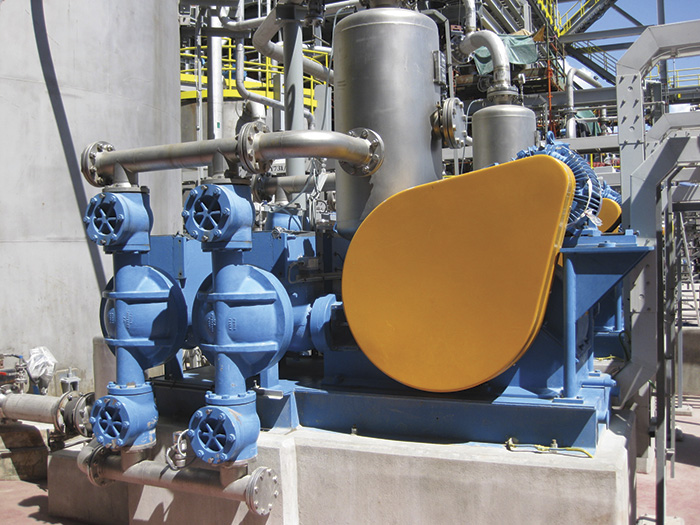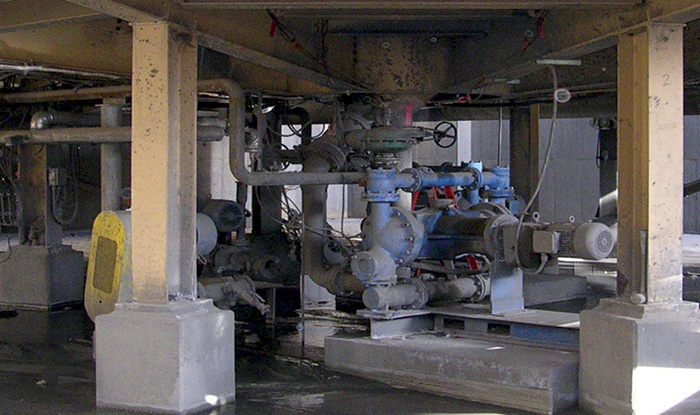Positive displacement (PD)pumps are chosen for some of the most challenging slurry pumping duties. Here are four important factors to consider when choosing a PD pump for mining applications.
1. Abrasive Wear
Mining slurries tend to be abrasive with solid specific gravities of 2.65 or more and slurry specific gravities of 1.65 or greater at solids concentrations as high as 70 percent. Abrasive wear varies with velocity. End users should consider the effects of abrasive wear during pump selection.
PD pumps operate at relatively slow speeds and are effective in transporting mineral slurries. This industry utilizes the progressive cavity and rotary lobe designs found in PD pumps; however, the slurry’s path travels through tight places, such as rotors and stators or lobes. These designs are unfavorable to abrasive wear in intense applications and should never be run dry.
One of the best pump options for this duty are piston diaphragm designs that can run dry and are highly abrasive-resilient. Slurry does not pass through tight constrictions. Instead, elastomer diaphragms are used, and they are relatively passive in displacing the slurry. As a result, the diaphragm’s fatigue limit—not so much the abrasion—determines the diaphragm life.
 Image 1. A piston diaphragm pump for a sulfide leach autoclave feed (Courtesy of ABEL Pumps)
Image 1. A piston diaphragm pump for a sulfide leach autoclave feed (Courtesy of ABEL Pumps)2. Maintenance
Some applications such as mine dewatering allow end users to pick between staging centrifugal pumps or using a high-pressure PD pump. Lowest initial capital cost often favors the staged centrifugal pumps; however, other factors need consideration.
Maintenance of centrifugal slurry pumps can be considerable compared with PD pumps, which require maintenance only on an annual or semi-annual basis.
3. Operating Efficiency
PD pump efficiencies may run as high as 90 percent. Centrifugal pumps have a peak efficiency at their best efficiency point, but actual efficiencies could be considerably lower.
In one example, six centrifugal pumps are placed in series to pump a tailings slurry at 55 percent solids with a combined discharge pressure of 1,022 pounds per square inch (psi). Capacity per pump is 910 gallons per minute (gpm). Assume efficiency per pump is 55 percent.
Power use per pump is 165 horsepower (hp) or 123 kilowatts (kW). For six pumps, the total power consumption is 738 kilowatts an hour (kW/hr) or about 6.1 million kilowatts a year (kW/year).
A PD piston diaphragm pump operating at 90 percent efficiency consumes, by comparison, about 3.7 million kW/year. Savings, assuming 10 cents per kW, is about $238,000 per year.
The six centrifugal pumps each need gland seal water. Assume each gland seal water pump uses 30 gpm of water, pumping at 750 psi and consuming 18 kW per gland seal water pump—or 107 kW for the six pumps. The pumps run 8,300 hours per year.
 Image 2. Electric diaphragm pump for gold tailings thickener underflow
Image 2. Electric diaphragm pump for gold tailings thickener underflowConsidering the water cost at 25 cents per 100 gallons and power cost at 10 cents per kW, the annual cost of water and energy for gland seal water is about $310,000. By comparison, this amount will be saved with PD pumps, which do not use gland seal water.
End users should also consider that PD piston diaphragm pumps can pump media with solids concentrations as high as 70 percent compared to generally lower concentrations possible for centrifugal pumps. The result is less slurry volume pumped and inherent improved efficiency.
In this example, the annual savings from using PD pumps are around $238,000 in energy plus $310,000 in gland seal water—for a total of roughly $548,000.
4. Pulsation & Dampening
Reciprocating piston pumps produce a pulsating flow. Pulsations can cause vibrations in piping, excessive acceleration head and vibrational influences on downstream processes. Pulsation dampeners can help mitigate the effects of this issue.
One kind of dampener is the bladder type. Air or nitrogen is added to the top of the vessel above the bladder at 70 to 80 percent of the process pressure. The pressure above the bladder does not need to be adjusted as long as the operating pressure is fairly constant.
With varying pressures such as those found in a filter press feed operation, the bladder style can be inadequate, making an air cap dampener preferable. The slurry compresses the air within the vessel, and the pulsations are attenuated. Air or nitrogen needs to be added regularly to the discharge dampener to replace the amount carried out by the slurry.
The amount of residual pulsation is a function of the pump’s stroke volume, the operating pressure, the dampener’s volume and a numerical constant for the pump. About 10 percent residual pulsation is a good value for most applications.
On the suction side, acceleration head is a factor that does not occur on non-reciprocating machines. Acceleration head affects the net positive suction head available (NPSHA).
Actual acceleration head is a function of specific gravity, pipe length, flow rate and stroke rate divided by pipe diameter squared, and a factor “Z” for the pump configuration. Suction dampeners are standard on larger piston diaphragm pumps.
On lower pressure systems, if the suction pipe length exceeds 10 feet, a pulsation dampener is recommended.


